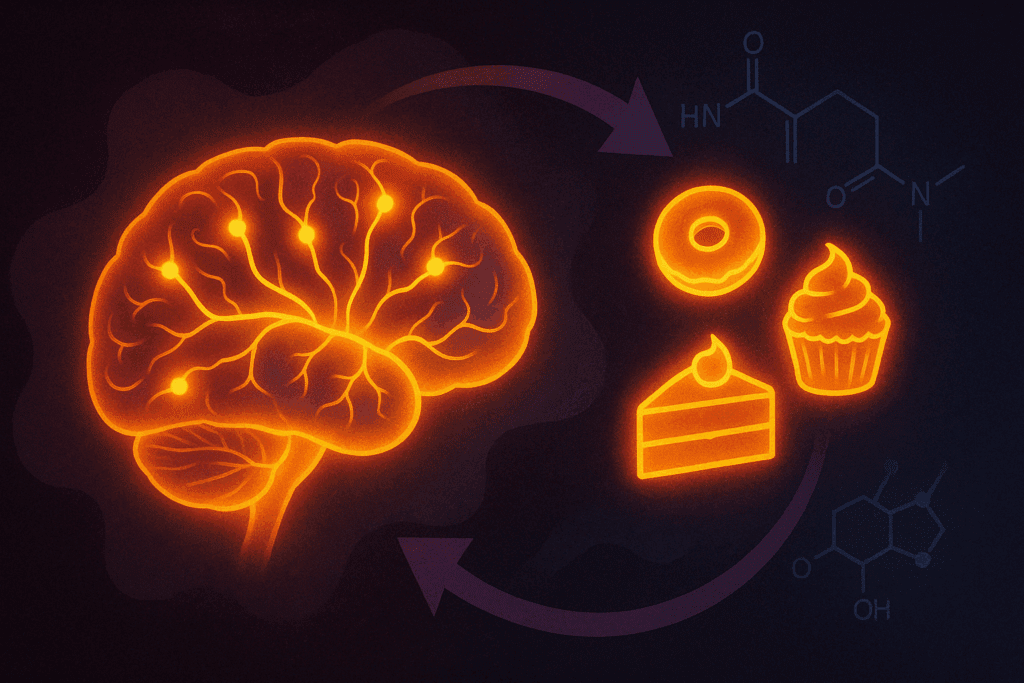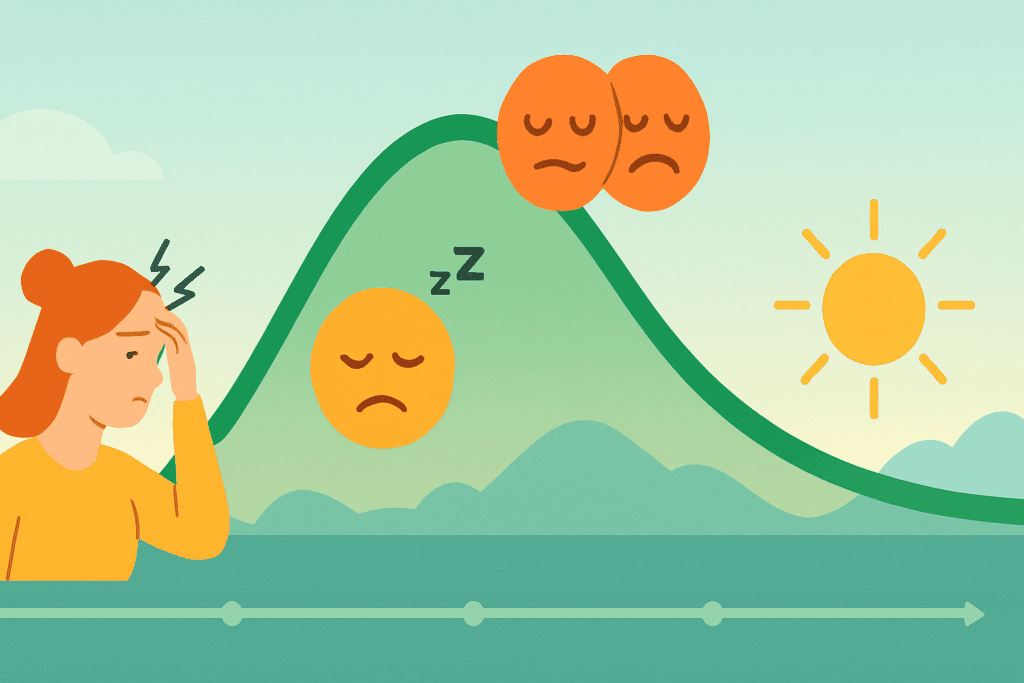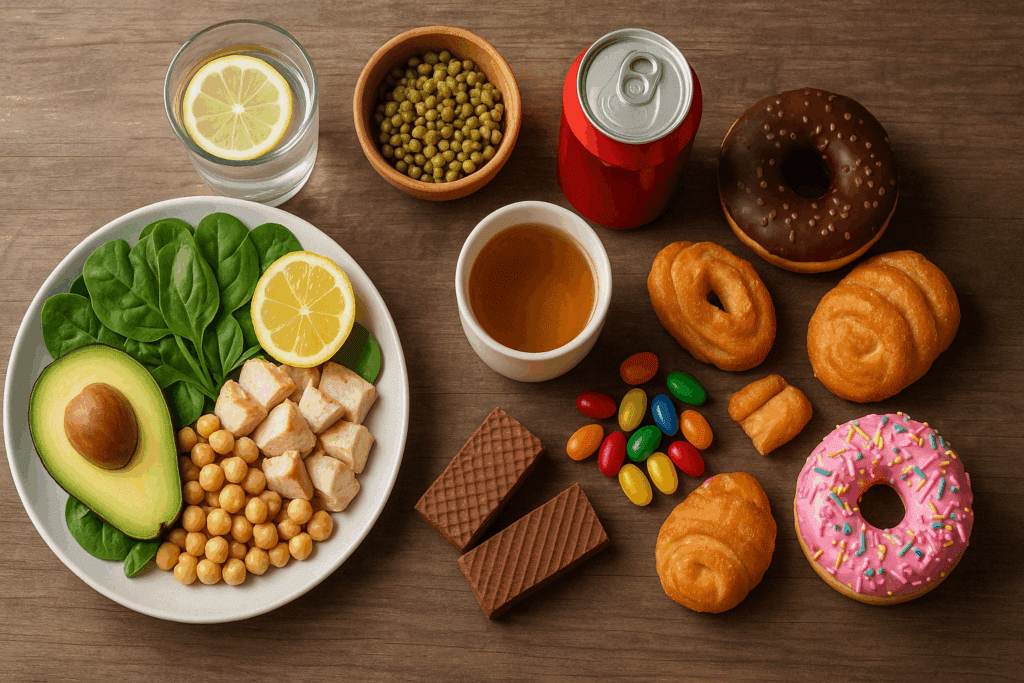In today’s modern food landscape, sugar seems nearly inescapable. From obvious sources like sodas and candies to hidden culprits in salad dressings and bread, added sugar quietly infiltrates the average diet. While sugar offers a quick energy boost, the long-term effects of excessive consumption are far from sweet. For many, the decision to reduce or eliminate added sugars marks a pivotal step toward better health—but it’s not without challenges. As soon as you begin cutting back, your body can respond with a range of sugar withdrawal symptoms that may feel surprisingly intense. Understanding these reactions, the sugar withdrawal timeline, and how to support your body through a sugar detox safely can make all the difference in long-term success.
Detoxing from sugar is not a gimmick—it’s a physiological process with real consequences for the brain, hormones, and metabolism. This article will walk you through what to expect from the sugar detox timeline, how to ease symptoms naturally, and what you can do to help your body adapt and thrive. Whether you’re looking for a sugar cleanse diet, wondering how long sugar withdrawal lasts, or seeking strategies to detox from sugar fast, this comprehensive guide is rooted in scientific insights and built on a foundation of practical advice.
You may also like: Why Am I Craving Sweets All of a Sudden? Expert-Backed Reasons and How to Stop Sugar Cravings Naturally

Why We Crave Sugar in the First Place
Sugar cravings are not just about willpower—they are driven by complex neurochemical interactions in the brain. When you consume sugar, dopamine, a neurotransmitter associated with pleasure and reward, surges in response. Over time, repeated sugar consumption can dull dopamine receptors, meaning it takes more sugar to achieve the same rewarding feeling. This cycle can become self-perpetuating, leading to increased dependence and, for some, signs that mimic addiction.
Beyond the neurological pull, sugar also disrupts insulin balance. As blood sugar levels spike and crash rapidly after sugar-laden meals, the body often responds with increased hunger and cravings for more sugar. These metabolic and hormonal shifts are part of why many people find quitting sugar cold turkey difficult. It’s not just psychological—your body is biologically adjusting.

The Reality of Sugar Withdrawal: What Symptoms Can You Expect?
When someone embarks on a sugar detoxification process, they are likely to experience a range of symptoms. The severity of sugar withdrawal symptoms varies based on how much sugar the individual regularly consumes and how abruptly they cut it out. Symptoms of sugar detox often emerge within the first 24 to 48 hours and can linger for several days or longer.
Common sugar withdrawal symptoms include fatigue, irritability, headaches, mood swings, and even flu-like sensations. Sugar withdrawal headache is one of the most frequently reported effects and may feel similar to a caffeine withdrawal migraine. Others experience difficulty concentrating, anxiety, or gastrointestinal discomfort such as bloating or nausea. These effects are temporary but can feel discouraging if you’re unprepared.
Interestingly, some people report unexpected symptoms during the sugar detox timeline, such as excessive sweating or changes in body odor. This leads to questions like: can quitting sugar help with sweating? While more research is needed, it’s possible that as the body rebalances its internal chemistry, temporary increases in sweat production may occur. These are not typically cause for concern and usually resolve within days.

Understanding the Sugar Withdrawal Timeline: From Day One to Recovery
The sugar withdrawal symptoms timeline can generally be broken into several phases, though each person’s experience may differ slightly. On the first day of eliminating added sugar, most people feel fine—sugar stores are still present in the bloodstream, and the withdrawal has not yet fully begun. By the second or third day, symptoms tend to peak. This is when cravings, headaches, and fatigue become most noticeable.
Between days three and five, these symptoms may intensify. This is often the most difficult period of the sugar detox timeline. The brain is adjusting to lower dopamine levels, and the body is recalibrating its insulin response. Many wonder how long do sugar withdrawal symptoms last, and fortunately, by the end of the first week, most people begin to feel relief.
By days seven to ten, symptoms generally subside, although some individuals may still experience lingering sugar cravings. By this point, the body is learning to utilize complex carbohydrates, fats, and proteins more efficiently for energy. This phase marks a turning point where the benefits of sugar detoxification—such as increased energy, better focus, and improved mood—start to become noticeable.
How Long Does It Take to Detox from Sugar Completely?
Many people ask, how long does it take sugar to leave your body? The answer depends on multiple factors, including metabolic rate, hydration, activity level, and the amount of sugar previously consumed. On average, it takes about three to five days for most added sugars to be metabolized and excreted. However, this does not mean all sugar withdrawal symptoms disappear by then.
When considering how long it takes to detox from sugar completely, it’s essential to distinguish between physical sugar withdrawal and behavioral sugar dependence. Physically, the effects may resolve in a week or two. Psychologically, however, it may take longer to break habits and emotional attachments to sugary foods. For some, the question becomes: how long for sugar to leave the body emotionally as well as physically? That answer can extend to several weeks or even months.
The Science Behind Sugar Detoxification and Hormonal Rebalancing
Detoxing from sugar is more than a buzzword—it represents a genuine metabolic shift in the body. During sugar detoxification, insulin sensitivity begins to improve. The pancreas, relieved from constantly releasing insulin in response to sugar intake, becomes more efficient. Blood sugar levels stabilize, and the risk of insulin resistance—an early marker of type 2 diabetes—begins to drop.
Additionally, as the gut microbiome recalibrates, cravings begin to diminish. Certain strains of gut bacteria thrive on sugar, and when sugar intake is high, these strains can proliferate. Once sugar is removed, these microbes decrease in number, which may directly influence how strong sugar cravings feel. This microbial shift contributes to both the symptoms of sugar detox and the long-term benefits of dietary change.

Navigating the Sugar Cleanse Diet: What to Eat and Avoid
A sugar cleanse diet is not about starvation or deprivation—it’s about nourishing the body with whole, unprocessed foods that support natural detoxification pathways. During the initial days of a sugar flush, it’s especially important to avoid ultra-processed foods, artificial sweeteners, and refined carbohydrates that can trigger the same insulin and dopamine surges as sugar.
Instead, focus on fiber-rich vegetables, legumes, whole grains, nuts, seeds, and lean proteins. These foods help regulate blood glucose levels and promote satiety, reducing the intensity of sugar cravings. For example, pairing a serving of steel-cut oats with almond butter and cinnamon can create a satisfying breakfast that supports energy and digestion during sugar withdrawal.
Hydration is also crucial. Drinking plenty of water supports kidney function and helps flush sugar byproducts from the system more efficiently. Some people explore how to detox your body from sugar quickly by using green teas, lemon water, or apple cider vinegar, though these should be viewed as supportive practices rather than miracle cures.
How to Detox from Sugar Fast—but Safely and Sustainably
For those eager to know how to detox from sugar fast, the answer lies in a balanced approach. While some advocate quitting sugar cold turkey, this method can lead to a surge of sugar withdrawal symptoms that may be overwhelming. A more sustainable strategy may be to eliminate added sugars all at once while still allowing small amounts of natural sugars from fruit during the initial phase.
Gradual reduction can also be effective, particularly for those with a high baseline sugar intake. Begin by removing sugary beverages, then transition to reducing desserts and processed snacks. Over time, the palate adjusts, and previously “normal” sweet foods may begin to taste excessively sugary. This recalibration makes long-term sugar detoxification easier to maintain.
Include healthy fats like avocado, chia seeds, or olive oil in meals to slow digestion and stabilize energy. This can minimize blood sugar fluctuations and reduce cravings. High-protein meals are also essential in preventing post-meal crashes that often lead to sugar-seeking behavior.
Recognizing the Subtle Signs of Quitting Sugar and What They Mean
Not all effects of sugar withdrawal are dramatic. Some signs of quitting sugar are more subtle and may even go unnoticed if you’re not paying attention. These might include improved skin clarity, reduced joint inflammation, better dental health, and enhanced sleep quality. For individuals wondering how to naturally detox your body from sugar, noticing these small wins can serve as valuable reinforcement.
However, it’s equally important to acknowledge the sugar free detox side effects. These may include temporary fatigue, irritability, or difficulty sleeping in the first few days. It’s helpful to remind yourself that these symptoms are part of the healing process and typically subside as the body reestablishes hormonal equilibrium.

How to Ease Sugar Withdrawal Symptoms Using Natural Strategies
Coping with sugar withdrawal symptoms effectively means addressing both the physical and emotional components of detox. Sleep is one of the most underappreciated tools in this process. During sleep, the body repairs cells and rebalances hormones like leptin and ghrelin, which regulate hunger and satiety. Prioritizing at least 7–9 hours of high-quality sleep each night can ease cravings and enhance mood.
Physical movement, particularly moderate aerobic exercise, supports the sugar detox process by increasing circulation and lymphatic drainage. This not only helps to rid your body of sugar faster but also boosts endorphin levels, acting as a natural counterbalance to the reduced dopamine from sugar restriction.
Mindfulness practices such as meditation, journaling, or breathwork can be valuable during sugar detoxification, especially when emotional cravings surface. Often, sugar cravings are not about hunger but about comfort or stress relief. Addressing these patterns with intention helps reduce the psychological grip sugar can have.
How to Stay Committed When Sugar Cravings Return
Understanding how long do sugar cravings last is key to staying the course. Most intense cravings subside within the first two weeks, but environmental triggers—like celebrations, stress, or social settings—can prompt relapses. The goal isn’t perfection, but progress. When cravings return, recognize them for what they are: temporary impulses, not commands.
Having sugar-free alternatives on hand, such as fruit with nut butter or a square of dark chocolate, can satisfy the urge without undoing progress. Over time, your preferences change, and the desire for ultra-sweet foods naturally diminishes. Reinforcing this transformation by reflecting on how far you’ve come can strengthen your resolve during moments of temptation.

The Role of a Sugar Flush in Long-Term Health and Lifestyle
A sugar flush is not just a quick fix—it can be a meaningful reset that reorients your relationship with food. After completing a sugar detox, many people find they have more energy, fewer mood swings, and better metabolic health markers. These benefits are not just anecdotal; clinical studies have shown that reducing added sugar intake can improve insulin sensitivity, reduce belly fat, and lower inflammation markers.
More importantly, sugar detoxification can spark a deeper awareness about how food influences emotional and physical health. It prompts critical questions like: how do you cleanse your body of sugar over time, and how do you create a sustainable lifestyle that honors both health and enjoyment? These reflections can pave the way for mindful eating habits that last a lifetime.
Frequently Asked Questions: Sugar Detox, Withdrawal, and Natural Recovery Insights
1. Are there psychological effects of sugar withdrawal that go beyond physical symptoms?
Yes, sugar withdrawal symptoms extend beyond just physical discomfort and can include emotional and cognitive shifts that catch many people off guard. Mood disturbances such as irritability, sadness, and even feelings resembling mild depression are common, particularly in the early days of a sugar detox. This is due to the abrupt drop in dopamine levels once sugar—a known trigger for pleasure pathways in the brain—is removed. Additionally, many individuals report difficulty concentrating or a mental fog that persists throughout the sugar withdrawal timeline. Emotional eating patterns may also be triggered, as people confront long-standing habits used to manage stress or reward themselves. Understanding these psychological effects is critical when planning how to detox your body from sugar in a sustainable, compassionate way.
2. What role do electrolytes play during a sugar detox, and should I supplement them?
During sugar detoxification, fluid balance in the body may shift, especially if you’re eating fewer processed foods, which are often loaded with sodium. As insulin levels drop, the kidneys excrete more sodium and water, which can lead to electrolyte imbalances. This can contribute to symptoms of sugar detox such as fatigue, dizziness, and even headaches. Some people find that including mineral-rich foods or lightly salting their meals helps ease these symptoms. In more severe cases, especially when detoxing quickly or quitting sugar cold turkey, electrolyte supplementation with potassium, magnesium, and sodium may help stabilize energy and improve hydration, minimizing common sugar withdrawal symptoms.
3. Can a sugar detox affect hormone balance, particularly in women?
Yes, the effects of sugar detox can temporarily impact hormonal rhythms, especially in women. Estrogen and progesterone levels are sensitive to dietary changes, and sudden removal of sugar can initially lead to irregular cycles or worsened PMS. However, over time, improved insulin sensitivity and stabilized blood glucose levels often lead to better hormonal harmony. This is particularly relevant for women with conditions like PCOS, where excess sugar exacerbates symptoms. It’s important to approach the sugar cleanse diet with nutrient density in mind—ensuring adequate healthy fats and protein to help regulate hormone production and reduce the likelihood of negative sugar withdrawal side effects.
4. Why do some people experience skin breakouts or rashes during a sugar flush?
Skin is a major detoxification organ, and during a sugar flush, the body is eliminating metabolic byproducts that may cause temporary flare-ups. This process can trigger symptoms that resemble acne, eczema, or redness as the system recalibrates. While these effects of sugar detox are often short-lived, they can be frustrating. Supporting your skin through gentle cleansing, hydration, and antioxidant-rich foods may help ease inflammation. Interestingly, these issues are often followed by significant improvements in skin clarity as the sugar withdrawal symptoms subside and internal inflammation decreases.
5. What is the difference between a sugar cleanse diet and a low-carb diet?
A sugar cleanse diet is designed specifically to eliminate added sugars and recalibrate taste preferences, while a low-carb diet focuses on overall carbohydrate reduction. Sugar detoxification targets refined sugars and syrups commonly added to processed foods, not necessarily whole-food carbohydrates like fruits or legumes. While the two may overlap, especially in the early stages, they serve different purposes. A sugar cleanse prioritizes metabolic balance and dopamine recalibration, whereas a low-carb diet often focuses on fat metabolism and ketone production. For those asking how long does it take sugar to leave your body, the answer may depend on which dietary approach is used, but both can be effective with appropriate planning.
6. How do gut bacteria influence sugar cravings during and after sugar withdrawal?
Emerging research suggests that certain gut microbes actually influence cravings for sugar-rich foods. When you stop consuming sugar, the sudden loss of their preferred fuel can create microbial die-off, contributing to bloating or other gastrointestinal symptoms of sugar detox. Over time, beneficial bacteria that thrive on fiber and complex carbs flourish, reducing cravings and supporting metabolic health. Including prebiotic-rich foods like leeks, asparagus, or oats during your sugar detox timeline can help facilitate this microbial shift. Understanding how to detox from sugar fast requires considering not just macronutrients, but the microbial ecosystem that drives many food-related behaviors.
7. Can quitting sugar help with sweating or improve body odor?
Yes, some individuals report that quitting sugar improves sweating patterns and reduces body odor. Excessive sugar intake can feed yeast and bacteria in the body, which may contribute to sour or sharp body odors. During sugar detoxification, these microorganisms often die off, and this transition can briefly intensify odor before things improve. Additionally, as blood glucose levels stabilize, the body reduces thermogenic spikes that can lead to hot flashes or sudden sweating. For those wondering, “Can quitting sugar help with sweating?” the answer is yes—but results vary and may take a few weeks to become noticeable.
8. What are lesser-known signs of quitting sugar that people often overlook?
Beyond the commonly discussed sugar withdrawal headache or fatigue, there are several subtler signs of quitting sugar. These include changes in taste sensitivity—where natural foods start to taste sweeter—as well as improved joint comfort and better sleep quality. Some people also report a more stable emotional baseline and fewer fluctuations in hunger throughout the day. These signs often emerge after the sugar withdrawal symptoms timeline has passed and can serve as powerful motivators to continue with sugar-free habits. Recognizing these subtle improvements reinforces long-term adherence to sugar detox protocols.
9. How can someone recover quickly from a relapse during the sugar detox process?
Relapses during sugar detoxification are common and not a sign of failure. What matters most is how you respond. The key is to avoid guilt and instead refocus your efforts with small, sustainable adjustments. Rehydrating, eating a high-fiber meal, and incorporating healthy fats can help rebalance blood sugar and minimize further cravings. Ask yourself what triggered the lapse—was it emotional, social, or biological? Learning from the experience builds resilience and supports long-term sugar detox success. Knowing how to detox from sugar quickly after a slip-up can help minimize setbacks and keep you on track without reinforcing shame or all-or-nothing thinking.
10. What long-term lifestyle changes support the effects of sugar detox beyond the initial cleanse?
Maintaining the benefits of a sugar flush requires embedding new habits into daily life. This means meal planning around whole foods, reading labels for hidden sugars, and finding healthy replacements for old favorites. Social support also plays a huge role—sharing your goals with others or joining a group focused on mindful eating can create accountability. Over time, many people find that their taste buds evolve, and they no longer enjoy the intensity of sugary foods. The long-term effects of sugar detox are not just metabolic—they also include improved self-awareness around food choices and a greater sense of control over your well-being. Whether you’re wondering how to rid your body of sugar or how long do sugar cravings last, the best strategy is to focus on sustainable daily practices that reinforce the progress you’ve already made.
Conclusion: How to Detox from Sugar Naturally and Reclaim Your Health
Detoxing from sugar is a powerful, science-backed approach to improving your health—but it’s not always easy. The sugar withdrawal symptoms timeline can include everything from headaches to fatigue, and cravings can feel intense during the first week. Still, understanding the physiological process behind sugar detoxification helps demystify the experience. By learning how to detox from sugar safely and applying natural, sustainable strategies, you support your body’s transition away from dependency and toward lasting balance.
So, how can you detox from sugar and make it stick? By approaching the process with knowledge, compassion, and realistic goals. Whether you’re dealing with a sugar withdrawal headache or wondering how long sugar cravings last, remember that your body is capable of healing—and your taste buds will adapt. Use supportive tools like a sugar cleanse diet, mindful meal planning, hydration, and stress reduction techniques to navigate the journey.
Ultimately, a successful sugar detox isn’t about restriction; it’s about liberation. It’s about breaking free from cycles of cravings and giving your body the nourishment it truly needs. When you rid your body of sugar and embrace whole, unprocessed foods, you’re not just managing symptoms—you’re reshaping your future health. And that transformation is not only possible—it’s profoundly rewarding.
Was this article helpful? Don’t let it stop with you. Share it right now with someone who needs to see it—whether it’s a friend, a colleague, or your whole network. And if staying ahead on this topic matters to you, subscribe to this publication for the most up-to-date information. You’ll get the latest insights delivered straight to you—no searching, no missing out.
Further Reading:
What to know about sugar detox symptoms
How Long Do Sugar Withdrawal Symptoms Last?
Disclaimer
The information contained in this article is provided for general informational purposes only and is not intended to serve as medical, legal, or professional advice. While NewsHealthWatch strives to present accurate, up-to-date, and reliable content, no warranty or guarantee, expressed or implied, is made regarding the completeness, accuracy, or adequacy of the information provided. Readers are strongly advised to seek the guidance of a qualified healthcare provider or other relevant professionals before acting on any information contained in this article. NewsHealthWatch, its authors, editors, and contributors expressly disclaim any liability for any damages, losses, or consequences arising directly or indirectly from the use, interpretation, or reliance on any information presented herein. The views and opinions expressed in this article are those of the author(s) and do not necessarily reflect the official policies or positions of NewsHealthWatch.

